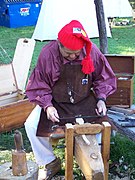Carving bench
The carving bench is a tool in traditional, often rural woodworking , on which wood is carved.
description
While a workbench is usually designed as a work table, the worker usually sits lengthways on the bench, which is accordingly also referred to as a cutting ass and carving horse . ( Donkey , buck and farmhand are names that are also used in the craft and farming sector for other holding or carrying equipment.)
The carving bench is used to place and fix wooden workpieces during their processing. It stands on three or four wooden legs. A clamping device (jaw) is generally attached to the long side. This stemmed clamp extends through a recess to the underside of the bench, where it can be moved forwards and backwards by placing one or both feet on a pedal .
The workpieces clamped at the top are often peeled or smoothed with a draw knife , a carving knife with a handle on both sides. Tool handles or other wooden bars as well as shingles can be made, which is why it is also called a shingle bench. Other typical uses are the carving (l) n of barrel staves by the cooper or the production of car spokes by the Wagner . It is advantageous that the worker has both hands free for carving because the clamping device of the carving bench holds the workpiece .
Designations
Other names are Heinzelbank in the Erzgebirge , Hoanzlbank in Flachgau , Pinzgau and in Lower Austria , pull horse , Schnitzelbock , Schnitzelbank , Zugbank or farmer's planer bench .
See also
Planing of long wood chips to make wooden baskets
Web links
Individual evidence
- ↑ Donkey , m (7) . In: Jacob Grimm , Wilhelm Grimm (Hrsg.): German dictionary . tape 3 : E – research - (III). S. Hirzel, Leipzig 1862 ( woerterbuchnetz.de ).
- ↑ donkey . In: JG Krünitz: Economic Encyclopedia . 1773-1858
- ↑ Donkey (2), the. In: Adelung: Grammatical-Critical Dictionary of High German Dialect . Volume 1. Leipzig 1793, pp. 1969-1970
- ↑ Donkey (3) . In: Universal Lexicon of the Present and Past . 4., reworked. and strongly increased edition, Volume 5: Germany – Euromos , Eigenverlag, Altenburg 1858, pp. 890–891 .
- ↑ Esel m in WDW online dictionary 3.0, international and interregional specialist dictionary on the language and culture of wine
- ↑ Hoanzlbank - Heinzel Bank . In: Austrian dictionary ; Retrieved July 5, 2013
- ↑ Reinhard Peesch : Wooden device in its original forms. Academy Publishing House . Berlin 1966, pp. 22-23.




